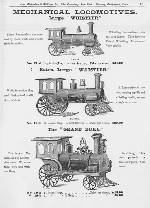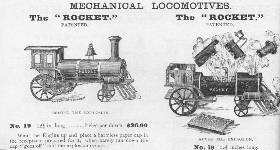
|
<<<< |

|
>>>> |

|

TRAINS ON U. S. STAMPS
and POSTAL STATIONERY
page 4c
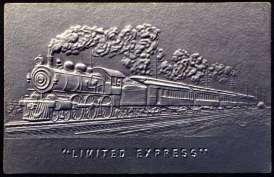
Embossed postcard with train image - Limited Express |
6¢ TOY TRAIN - 1970 CONTEMPORARY CHRISTMAS ISSUE
|
|||||||||
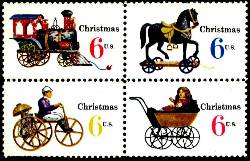
Scott 1415-18, 6 red, yellow, blue and black issued 11/5/70 |

Sc. 1415 |
Every year since 1962, the USPOD/USPS has issued special stamps at Christmas. 1970 was the first year they issued both a religious or "traditional" design, and a secular or "contemporary" one. Our train stamp was one of the four setenant stamps of the contemporary issue - it's at the top left in the block above, Scott 1415.
The train on this stamp was described in USPOD publicity as an 1880 tin and cast-iron Ives Co. 2-2-0 locomotive No. 19- 5, "Grand Duke." There is one inconsistency in the image on the stamp - the cord and ball at the front imply a pull-toy, but the clockwork mechanism visible between the two rear wheels implies a windup toy. Could the cord be a mistake? Scott's notation about the stamps says "from a drawing (locomotive) by Charles Hemming". (The rest of the toys were taken from the book The Golden Age of Toys by Fondin and Remise).
I was curious whether I could comfirm the design source after all this time. And what about the cord?
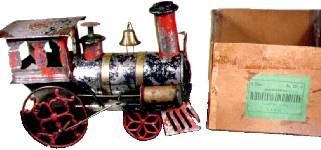
1880's Toy train - Ives Whistler |
A quick search on the WWW led us to Dave McEntarfer of the Ives Train Society ( The Ives Train Society), who provided the scan above, of an original toy that is almost identical to the one on the stamp, though he identified this as a "Whistler" of the period. Close, but no cigar. Note the rear wheels, for instance, and the bell housing. Not the same.
When I first started researching this topic three years ago, that was as far as I was able to get. Recently I tried again, and found the relatively new site of the Train Collectors Association (http://www.tcamembers.org), with images of ads for Ives toys of the late 19th century, so I emailed them for assistance, and received in return the images and message below.
Mr Senkus - I checked several books and catalogs and the USPS information on the stamp appears to be accurate. Both the "Grand Duke" and the "Whistler" were mechanical, so the pull string would not be required for either of them. Attached is a scan from an 1893 Ives, Blakeslee & Williams Co. 1893 catalog, showing the "Grand Duke". It was produced as early as the 1880s. Jan Athey, Librarian
Our thanks to Ms. Athey. Case closed.

Sc. 1415a - issued 11/5/70 |
The 1970 Christmas stamps were issued in 68 cities in experimental "integrated precancel" form (meaning the precancel was printed with the rest of the stamp design, rather than afterwards as a separate step). Unlike most precancels, this one was intended for ordinary mortals. Anyone could buy and use the stamps, the idea being that mail carrying them could skip a processing step - the canceling. However, I am told that users of the precanceled stamps had to hand their mail to a clerk, rather than just dropping it in any mail box or slot, which strikes me as a big dis-incentive to use them at all.
The precancel is just two wavy lines printed across the face of each stamp. You might think the precanceled stamps would lack tagging, but you would be wrong - both versions are tagged. There had been a similar experiment the preceding Christmas, as there was again the following one, but then the idea was dropped. I suspect they found the work saved was not enough to justify the added costs, or that the sorting equipment evolved to a point where the canceling step was so integral to the process that there was no savings in skipping it.
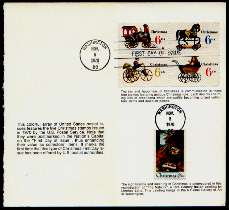
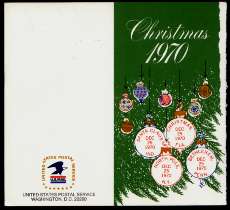
|
None of my FDCs for this issue is worthy of note, but the item above is a bit unusual. It has been in my collection for many years, and I had never really looked at it until I started researching this article. It's an official USPS First Day card for the 1970 Christmas stamps. I pulled it out just now to see whether it had any interest, and wondered why I'd even kept it - the bland cover and officialese text add nothing to the stamps. But then I noticed this sentence - "It marks the first time that this type of Christmas First Day Issue has been offered by U.S. postal authorities." What does that mean?
One possibility that occurred to me was that the card itself was considered somehow revolutionary - an official FDC. I still think that is possible, as until recently the USPS (wisely, I think) did not produce official FDCs. Was the card given away? Or sold? I suspect the latter.
Then I looked at my USPS "Guide" and realized that 1970 was the first year the USPS had released both a "contemporary" (secular) and a "traditional" (religious) stamp issue for Christmas. The series started in 1962, and each year until 1970 there had been either a secular or a religious stamp, but not both. So perhaps this card was their way of advertising that "innovation". (I welcome any further information - or even speculation - anyone can provide about it.)
I published this article in The Dispatcher, newsletter of the Casey Jones Rail Road Unit of the ATA, and Jerry Husak (#17), founder of the ATA and one of the founders of the CJRRU as well, wrote as follows:
The card was sold for $1 or $2 by the USPS as a Christmas card. It arrived flat, and included a white envelope, ready to be signed, folded, stamped and mailed. If most mailed them, the flat version could be scarce! I doubt many were sold, as the USPS discontinued such cards the following year.
Our copy is not folded, so we're off to eBay to sell it and make our fortune.
The stamp was designed by Stevan Dohanos, and printed in photogravure. 929 million stamps were printed, of which 489.2 million were 1415-18 (unprecanceled) and 439.6 were 1415-18a (precanceled). That means there were 122 million copies of 1415, and 110 million of 1415a. Given those numbers, these stamps should be plentiful, but they must have been popular for their thematic content, as Scott lists the normal/precanc. mint value as 30/75 cents per stamp, or $1.25/3.25 for the block of four. Nonetheless I have purchased the normal variety at close to face value fairly recently, and Karl Anderson, the biggest US dealer in mint panes, has offered panes of 50 at $7 each, so you should be able to buy these in quantity at a reasonable price.

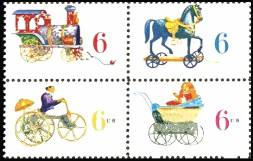
Left: Scott 1418b Right: Scott 1418e - black omitted error |
There is a black-omitted error version of this issue, valued at $2,500 per stamp, with 5 or 6 blocks known. Above is an example of the full block, from a recent Shreves auction. It sold for $2,700, against a pre-auction estimate of $5,000. Note how dramatically the omission of black affects the appearance of these stamps.
There is an imperf error involving 1416 and 1418, but none with 1415.
In the 1970 Linn's Stamp Popularity Poll, conducted annually since 1948, the Christmas Toys issue was voted "least necessary". Prior train stamps that "scored" in the Poll were the Casey Jones stamp, 1950, which tied with the California Statehood Commemorative for worst design{!} and the 1952 B&O commemorative, which was also voted "least necessary". That's' not popularity, it's notoriety.
Finally, since this stamp's design was based on an Ives toy, below are a couple of bonuses:
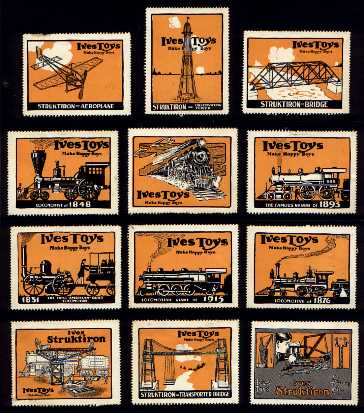
Poster stamps advertising Ives Toys, 1915 |
That is a complete set (12) of these cinderellas, which are not scarce, but they are popular with toy collectors as well as stamp collectors, and usually sell for at least $10 apiece, so a complete set will cost you over $100. Dave McEntarfer writes:
These poster stamps are from 1915 - I have a copy of The Saturday Evening Post from November 20, 1915 (Page 60) - that advertises "A set of Splendid Poster Stamps FREE." You just had to write and give them your toy dealer's address and they sent them to you. The ad states that 6 show the progression of the railroad and 6 show Ives' new Struktiron construction sets.
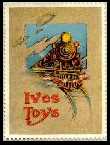
Poster stamp - Ives Toys |
The stamp above is a lone Ives poster stamp from 1913, reproducing the cover of the Ives catalog of that year. It is apparently a great rarity, as my expert sources know of only three copies still in existence.
US TRAINS
|
Send feedback to the webmaster: CLICK HERE
Revised -- 10/31/2005
